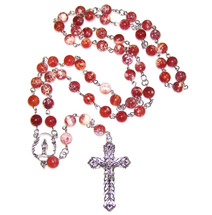Posted by Rod Connors on 24th May 2023
Create your own Rosary with our Rosary Making Kits
Have you every thought about creating your own Rosary? We have Rosary Making Kits that walk you through each step of the creative process. The kits contain all the beads, all the wire, the crucifix and center needed, and illustrated directions that walk you through the design process. You will need to have your own cutting pliers and round nose pliers which are both available on our website for a very reasonable price. We also have Rosary Bracelet Kits available.
The history of rosary making is closely tied to the development and spread of the rosary as a religious devotion within the Catholic Church.
- Origins: The origins of the rosary can be traced back to the early centuries of Christianity. Monks and nuns would use pebbles or small stones to keep count of their prayers. This practice evolved into the use of strings of beads or knots to aid in prayer recitation.
- Evolution in the Middle Ages: The modern form of the rosary began to take shape in the 12th and 13th centuries. It was during this period that the Hail Mary prayer became more widely known and recited. The repetition of prayers was associated with the contemplation of the life of Jesus and Mary.
- St. Dominic and the Dominican Order: The rosary as we know it today is often attributed to St. Dominic, a Spanish priest and the founder of the Dominican Order. According to tradition, the Virgin Mary appeared to St. Dominic and gave him the rosary as a spiritual weapon against heresy. The Dominicans played a significant role in promoting the rosary devotion and its widespread use.
- Development of the Mysteries: Over time, the rosary prayers became associated with specific mysteries or events from the lives of Jesus and Mary. Initially, there were three sets of mysteries: the Joyful, the Sorrowful, and the Glorious. In 2002, Pope John Paul II introduced the Luminous Mysteries, which focus on key moments from Jesus' public ministry.
- Popularization and Spread: The rosary gained popularity in Europe during the medieval period and became an integral part of Catholic devotional life. It was seen as a powerful tool for spiritual meditation, intercession, and protection. The printing press facilitated the widespread dissemination of rosary prayers and aided in the popularity of the devotion.
- Rosary Beads: The use of rosary beads, or "rosaries," became prevalent in the 15th century. Rosaries consisted of a string of beads with a crucifix or a centerpiece and were used as aids in counting prayers. The standard structure of a rosary consists of five sets of ten beads (decades) separated by larger beads or more spacing, with additional beads for introductory and concluding prayers.
- Variations and Cultural Influence: Throughout history, variations of the rosary beads have emerged. Different cultures and regions developed unique styles of rosaries, incorporating local materials, designs, and religious symbols. Rosaries made from precious metals, gemstones, wood, or other materials became treasured religious items and family heirlooms.
- Modern Rosary Making: Today, rosaries are made by skilled artisans, religious communities, and individuals. They are crafted using a wide range of materials, including beads made from various gemstones, glass, wood, or plastic. The beads are often strung together using durable cords or wire, and the crucifix and centerpiece may be made of metal or other materials.
The art of rosary making continues to thrive, with a diverse array of styles and designs available. Rosaries serve as both religious objects and cherished personal items, facilitating devotion, prayer, and spiritual reflection for Catholics and individuals of other Christian denominations.


